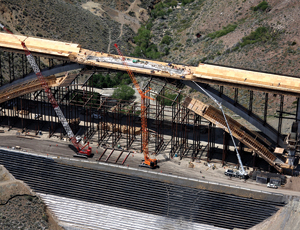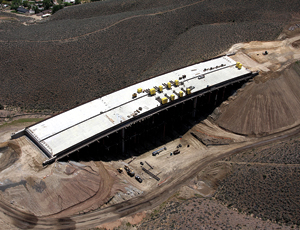A cathedral-arch bridge—the nation’s longest at 525 meters—is inching toward completion in a rural patch of northern Nevada three years after the original contractor left the project. The 90-m-tall structure, which spans Galena Creek, is part of the $600-million, 8.5-mile Interstate 580 extension between Reno and Carson City, now millions of dollars over budget and four years late.


It is the most costly project in state transportation history, requiring pavement maintenance cuts to pay for the added expenses. The cast-in-place concrete, steel-reinforced bridge consists of two parallel, 14-m-wide three-lane structures with 210-m center spans.
In May 2006, Edward Kraemer & Sons Inc., Plain, Wis., and Nevada’s Transportation Dept. dropped competing claims and parted ways. The impasse centered on the agency’s self-engineered, cast-in-place, pilot-truss bridge erection method, which Kraemer felt was unfeasible. The method called for bolting and welding 18 steel segments together to create a structural framework for wrapping rebar and concrete around trusses to form the arch. Kraemer received 58.6% of its $79.5-million Galena Creek bridge contract, leaving the job about 40% complete. Kraemer also left three smaller approach bridges close to completion.
The project was rebid, calling for the same pilot-truss method. On Nov. 6, 2006, despite being 19.1% above the engineer’s estimate, Fisher Sand & Gravel Co., Dickinson, N.D., won the $393.3-million contract that also included building 8.5 miles of four-lane divided road.
“We had to do a complete inventory. The job wasn’t closed down in any orderly fashion. They cut costs, leaving it up to the second contractor,” says Joseph Miller, Fisher’s Nevada manager. “A lot of contractors and their bonding companies were nervous about [pursuing the project],” which drew only two bids, he notes.
Like its predecessor, Fisher rejected the state’s pilot-truss erection method, calling it a “liability issue.” Instead, crews are temporarily raising the creek floor elevation by 140 ft, using 450,000 cu m of compacted soil placed with five conveyor belts, each 1.3 m wide x 68 m long. Next, they created a 13-m-dia, 7-m-tall, 1-m-thick temporary bridge arch with shotcrete reinforced with rebar, and are using a custom-fabricated interior slip-form that enables 12-m sectional pours.
“When you get up that high, there is no other way to do it,” Miller says. The erection method shaved 100 days from the 1,000-day schedule, which carries $27,500 a day in late penalties. The project is now on schedule and estimated to finish in fall 2011.
The six-lane freeway will bypass an accident-prone stretch of U.S. Highway 395 through Pleasant Valley that handles 40,000 vehicles daily. The job requires 4.6 million cu m of excavation, 55,000 sq m of concrete paving and 128,000 tonnes of asphalt. Fisher is self-producing concrete, asphalt and aggregates on-site, with 21 state-approved mix designs. It partnered with C.C. Myers Inc., Rancho Cordova, Calif., for 10 other cast-in-place, post-tensioned box-girder bridges, which comprise $130 million of the job.
In 2007, the state required a cost-benefit analysis on all transportation projects over $25 million. Nevada’s Transportation Dept. now faces a $7-billion funding shortfall over the next decade.
“We decreased our capital improvement program...and cut down greatly on consultant design work,” says Nevada Transportation Director Susan Martinovich. “Our next three years are very, very lean.”

Post a comment to this article
Report Abusive Comment